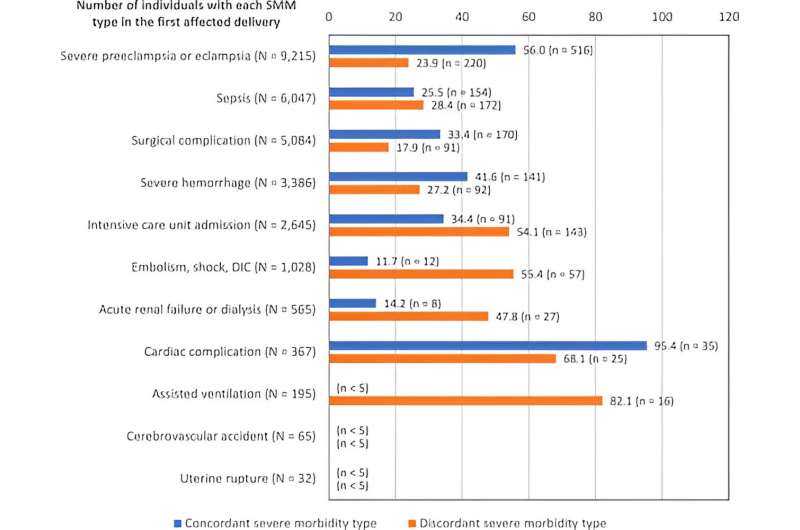This article has been reviewed according to Science X's editorial process and policies. Editors have highlighted the following attributes while ensuring the content's credibility:
fact-checked
peer-reviewed publication
trusted source
proofread
Severe maternal complications at childbirth: A recurring hazard?

About 1–3% of women who give birth in Canada experience serious complications during childbirth such as severe hemorrhage or severe preeclampsia. After surviving these complications (collectively termed "severe maternal morbidity"), many of these women may wish to conceive again in the future but would want to understand the risk associated with a new pregnancy and delivery.
A study conducted at the Research Institute of the McGill University Health Centre (RI-MUHC) and recently published in the American Journal of Obstetrics & Gynecology provides detailed data around recurrent complications for such women. The study, which looked at pregnancies in the province of Quebec over 32 years, shows that these women are in fact three times more likely to experience any severe maternal morbidity during a second delivery than those who did not have any serious complications at their first delivery.
Severe maternal morbidity are unexpected outcomes that generally occur during labor or delivery (or in the previous or following weeks) that have serious short- or long-term effects on women's health and well-being. Monitoring them has become a public health priority aimed at improving the quality of clinical care and maternal health.
"Severe maternal morbidity is linked with maternal mortality and prolonged hospitalization, but until now, little was known about recurrence of severe maternal morbidity in a subsequent delivery," says Dr. Natalie Dayan, senior author of the study and scientist in the Cardiovascular Health Across the Lifespan Program at the RI-MUHC.
"Our study provides quantitative estimates about maternal complications in a subsequent birth and shows that the risk of recurrent severe maternal morbidity is greatest for women with cardiac complications or uterine rupture at first delivery."
"This knowledge will help counsel women about future pregnancy risks, as well as plan and allocate resources to provide care for these women if they do conceive again," adds Dr. Dayan.
Detailed observations from a large cohort study
This research study used a population-based cohort of 1,406,874 women who had a pregnancy between 1989 and 2021 in Quebec, and analyzed the cases of 819,375 women who had at least two singleton hospital deliveries during that time. Of them, 25,873 (3.2%) women experienced severe maternal morbidity in their first delivery.
In women with prior severe maternal morbidity, the rate of severe maternal morbidity recurrence at second delivery was 65.2 per 1,000, vs. 20.3 per 1,000 in women with unaffected first delivery.
A closer look at cardiac complications
The researchers also examined the associations between specific complications at first and second delivery. They found that women with cardiac complications at first delivery had the highest risk of severe maternal morbidity in the next delivery—seven times higher than women who had no complications at first delivery. Further, they observed that experiencing any kind of serious complication at first delivery was strongly associated with cardiac complications and severe preeclampsia at a subsequent birth.
Some complications appeared more likely to recur during a second birth such as cardiac events, severe pre-eclampsia or eclampsia, severe hemorrhage and surgical complications. In contrast, other types of complications, such as acute renal failure, embolism, shock or disseminated intravascular coagulation and sepsis, did not recur as often.
Of note, women who experienced severe maternal morbidity at first delivery were more likely to be older than 35 years, to have pre-existing comorbidities and to be socioeconomically deprived—factors already known to increase the risk of complications. Estimates were adjusted in the study to account for that reality.
Although these results paint a picture of the situation in Quebec, the authors of the study consider them generalizable to the population of Canada and other countries with diverse and multiethnic populations and universal health care.
Answering women's needs
Before conducting this study, the researchers consulted members of the Maternal Near Miss Survivor group, counting over 1,000 women in North America who nearly died but survived a complication that occurred during pregnancy, childbirth or shortly after. One of their main health priorities regarding pregnancy was reproductive outcomes, including risks associated with a future pregnancy.
"While maternal mortality has declined in high-income countries, not much progress appears to have been made in reducing severe maternal morbidity in the Global North, and research on this topic has been limited, especially in Canada. Our study fills this gap by using a large provincial data set to provide evidence on the risk of recurrence of serious pregnancy complications and to facilitate future (inter)pregnancy care and counseling," says Ugochinyere Vivian Ukah, lead author of the study and a researcher at HealthPartners Institute, U.S., also a former postdoctoral fellow at McGill University with Dr. Dayan.
"Improving maternal health includes, of course, avoiding maternal and infant death and bringing that number as close to zero as possible. However, we must also do better at preventing severe maternal morbidity and its consequences—such conditions can significantly affect a woman's quality of life during her prime years," adds Dr. Dayan, who is also an epidemiologist, obstetric internist at the MUHC and an associate professor in the Department of Medicine at McGill University.
"Our next steps are to examine mental health and cardiovascular outcomes, as well as health care utilization (i.e., ED visits, hospitalizations and outpatient visits) following severe maternal morbidity in all of Canada. These will hopefully inform public health policy and the planning of postpartum care, especially for women who have had these near miss complications."
More information: Ugochinyere Vivian Ukah et al, Risk of recurrent severe maternal morbidity: a population-based study, American Journal of Obstetrics and Gynecology (2023). DOI: 10.1016/j.ajog.2023.06.010


















